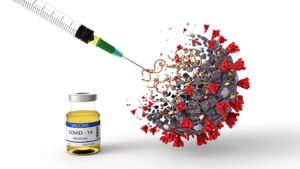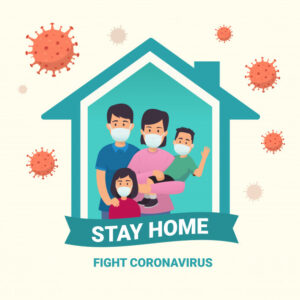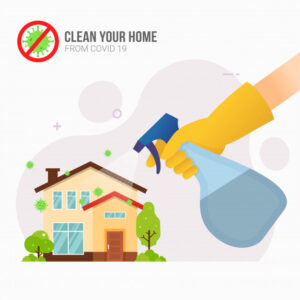Criteria for Return to Work – healthcare personnel

Who this is for: Occupational health programs and public health officials making decisions about return to work for healthcare personnel (HCP) with confirmed SARS-CoV-2 infection, or who have suspected SARS-CoV-2 infection (e.g., developed symptoms of COVID-19) but were never tested for SARS-CoV-2.
HCP with symptoms of COVID-19 should be prioritized for viral testing with approved nucleic acid or antigen detection assays. When a clinician decides that testing a person for SARS-CoV-2 is indicated, negative results from at least one FDA Emergency Use Authorized COVID-19 molecular viral assay for detection of SARS-CoV-2 RNA indicates that the person most likely does not have an active SARS-CoV-2 infection at the time the sample was collected. A second test for SARS-CoV-2 RNA may be performed at the discretion of the evaluating healthcare provider, particularly when a higher level of clinical suspicion for SARS-CoV-2 infection exists. For HCP who were suspected of having COVID-19 and had it ruled out, either with at least one negative test or a clinical decision that COVID-19 is not suspected and testing is not indicated, then return to work decisions should be based on their other suspected or confirmed diagnoses.
Decisions about return to work for HCP with SARS-CoV-2 infection should be made in the context of local circumstances. In general, a symptom-based strategy should be used as described below. The time period used depends on the HCP’s severity of illness and if they are severely immunocompromised
A test-based strategy is no longer recommended (except as noted below) because, in the majority of cases, it results in excluding from work HCP who continue to shed detectable SARS-CoV-2 RNA but are no longer infectious.
Other Resources:
For guidance about assessment of risk and application of work restrictions for asymptomatic HCP with potential exposure to patients, visitors, or other HCP with confirmed COVID-19, refer to the Interim U.S. Guidance for Risk Assessment and Work Restrictions for Healthcare Personnel with Potential Exposure to COVID-19.
Return to Work Criteria for HCP with SARS-CoV-2 Infection Symptom-based strategy for determining when HCP can return to work.
HCP with mild to moderate illness who are not severely immunocompromised:
 At least 10 days have passed since symptoms first appeared and
At least 10 days have passed since symptoms first appeared and
At least 24 hours have passed since last fever without the use of fever-reducing medications and
Symptoms (e.g., cough, shortness of breath) have improved
Note: HCP who are not severely immunocompromised and were asymptomatic throughout their infection may return to work when at least 10 days have passed since the date of their first positive viral diagnostic test.
HCP with severe to critical illness or who are severely immunocompromised1:
 At least 10 days and up to 20 days have passed since symptoms first appeared
At least 10 days and up to 20 days have passed since symptoms first appeared
At least 24 hours have passed since last fever without the use of fever-reducing medications and
Symptoms (e.g., cough, shortness of breath) have improved
Consider consultation with infection control experts
Note: HCP who are severely immunocompromised but who were asymptomatic throughout their infection may return to work when at least 10 days and up to 20 days have passed since the date of their first positive viral diagnostic test.
As described in the Decision Memo, an estimated 95% of severely or critically ill patients, including some with severe immunocompromise, no longer had replication-competent virus 15 days after onset of symptoms; no patient had replication-competent virus more than 20 days after onset of symptoms. The exact criteria that determine which HCP will shed replication-competent virus for longer periods are not known. Disease severity factors and the presence of immunocompromising conditions should be considered in determining the appropriate duration for specific HCP. For example, HCP with characteristics of severe illness may be most appropriately managed with at least 15 days before return to work.
Test-Based Strategy for Determining when HCP Can Return to Work.
In some instances, a test-based strategy could be considered to allow HCP to return to work earlier than if the symptom-based strategy were used. However, as described in the Decision Memo, many individuals will have prolonged viral shedding, limiting the utility of this approach.
A test-based strategy could also be considered for some HCP (e.g., those who are severely immunocompromised1) in consultation with local infectious diseases experts if concerns exist for the HCP being infectious for more than 20 days.
The criteria for the test-based strategy are:
 HCP who are symptomatic:
HCP who are symptomatic:
Resolution of fever without the use of fever-reducing medications and Improvement in symptoms, and Results are negative from at least two consecutive respiratory specimens collected ≥ Twenty-four hours apart (total of two negative specimens) tested using an FDA-authorized molecular viral assay to detect SARS-CoV-2 RNA. See Interim Guidelines for Collecting, Handling, and Testing Clinical Specimens for 2019 Novel Coronavirus (2019-nCoV).
HCP who are not symptomatic:
Results are negative from at least two consecutive respiratory specimens collected ≥ Twenty-four hours apart (total of two negative specimens) tested using an FDA-authorized molecular viral assay to detect SARS-CoV-2 RNA. See Interim Guidelines for Collecting, Handling, and Testing Clinical Specimens for 2019 Novel Coronavirus (2019-nCoV).
Return to Work Practices and Work Restrictions
After returning to work, HCP should:
Wear a facemask for source control at all times while in the healthcare facility until all symptoms are completely resolved or at baseline. A facemask instead of a cloth face covering should be used by these HCP for source control during this time period while in the facility. After this time period, these HCP should revert to their facility policy regarding universal source control during the pandemic.
A facemask for source control does not replace the need to wear an N95 or equivalent or higher-level respirator (or other recommended PPE) when indicated, including when caring for patients with suspected or confirmed SARS-CoV-2 infection. Self-monitor for symptoms, and seek re-evaluation from occupational health if symptoms recur or worsen.
Strategies to Mitigate Healthcare Personnel Staffing Shortages
Maintaining appropriate staffing in healthcare facilities is essential to providing a safe work environment for HCP and safe patient care. As the COVID-19 pandemic progresses, staffing shortages will likely occur due to HCP exposures, illness, or need to care for family members at home. Healthcare facilities must be prepared for potential staffing shortages and have plans and processes in place to mitigate them, including considerations for permitting HCP to return to work without meeting all return to work criteria above. Refer to the Strategies to Mitigate Healthcare Personnel Staffing Shortages document for information.
Definitions
Cloth face covering: Textile (cloth) covers are intended to keep the person wearing one from spreading respiratory secretions when talking, sneezing, or coughing. They are not PPE, and it is uncertain whether cloth face coverings protect the wearer. CDC has guidance available on design, use, and maintenance of cloth face coverings.
Facemask: Facemasks are PPE and are often referred to as surgical masks or procedure masks. Use facemasks according to product labeling and local, state, and federal requirements. FDA-cleared surgical masks are designed to protect against splashes and sprays and are prioritized for use when such exposures are anticipated, including surgical procedures. Facemasks that are not regulated by FDA, such as some procedure masks, which are typically used for isolation purposes, may not provide protection against splashes and sprays.
Respirator: A respirator is a personal protective device that is worn on the face, covers at least the nose and mouth, and is used to reduce the wearer’s risk of inhaling hazardous airborne particles (including dust particles and infectious agents), gases, or vapors. Respirators are certified by the CDC/NIOSH, including those intended for use in healthcare.
SARS-CoV-2 Illness Severity Criteria (adapted from the NIH COVID-19 Treatment Guidelinesexternal icon):
Note: The studies used to inform this guidance did not clearly define “severe” or “critical” illness. This guidance has taken a conservative approach to define these categories. Although not developed to inform decisions about when HCP with SARS-CoV-2 infection may return to work, the definitions in the National Institutes of Health (NIH) COVID-19 Treatment Guidelinesexternal icon are one option for defining severity of illness categories. The highest level of illness severity experienced by the HCP at any point in their clinical course should be used when determining when they may return to work.
Mild Illness: Individuals who have any of the various signs and symptoms of COVID 19 (e.g., fever, cough, sore throat, malaise, headache, muscle pain) without shortness of breath, dyspnea, or abnormal chest imaging.
Moderate Illness: Individuals who have evidence of lower respiratory disease by clinical assessment or imaging and a saturation of oxygen (SpO2) ≥۹۴% on room air at sea level.
Severe Illness: Individuals who have respiratory frequency >30 breaths per minute, SpO2 <94% on room air at sea level (or, for patients with chronic hypoxemia, a decrease from baseline of >3%), ratio of arterial partial pressure of oxygen to fraction of inspired oxygen (PaO2/FiO2) <300 mmHg, or lung infiltrates >50%.
Critical Illness: Individuals who have respiratory failure, septic shock, and/or multiple organ dysfunction.

Prepared:
Neshat Khosravi – Microbiologist
Refrence:
https://www.cdc.gov



Recent Comments